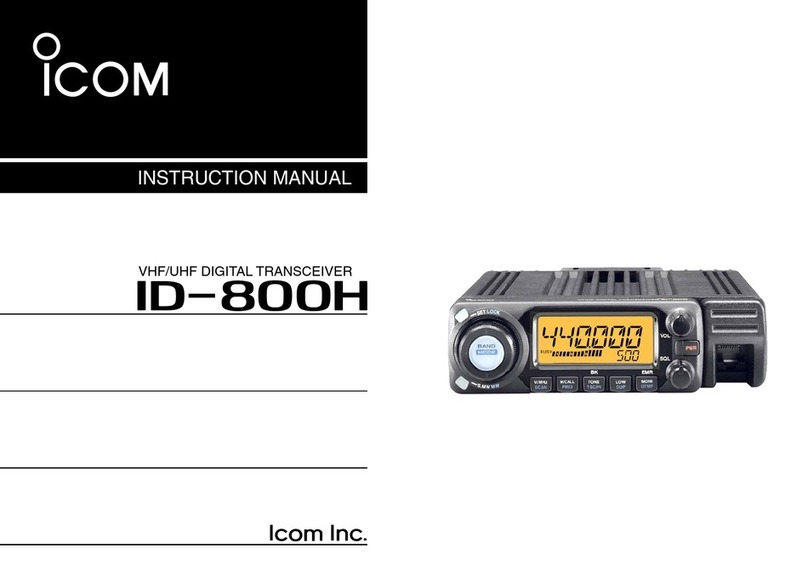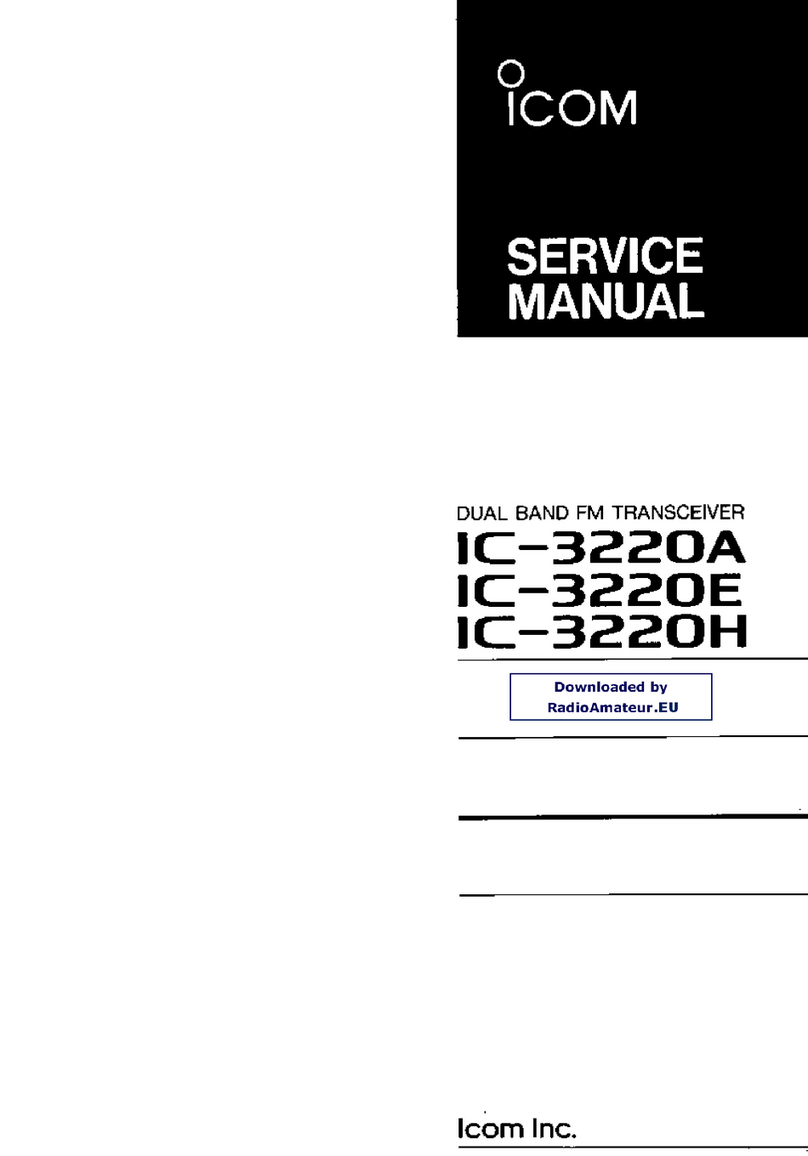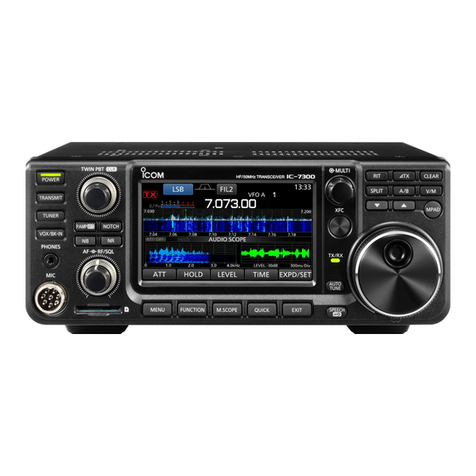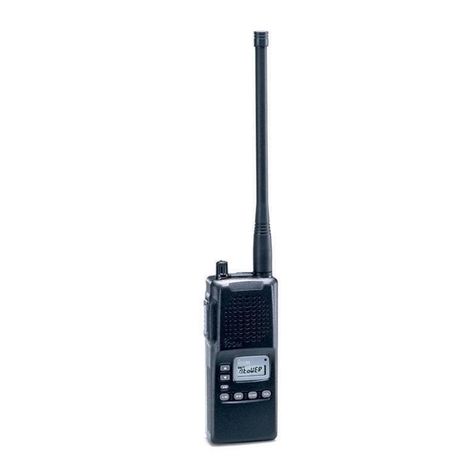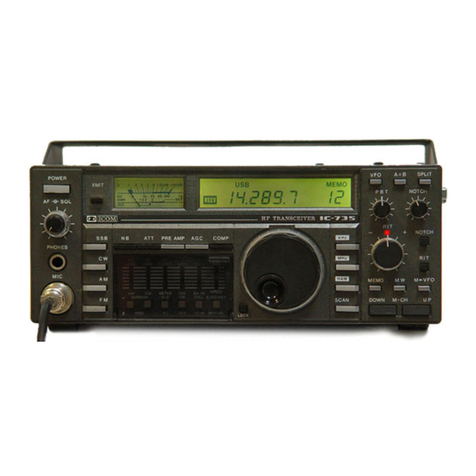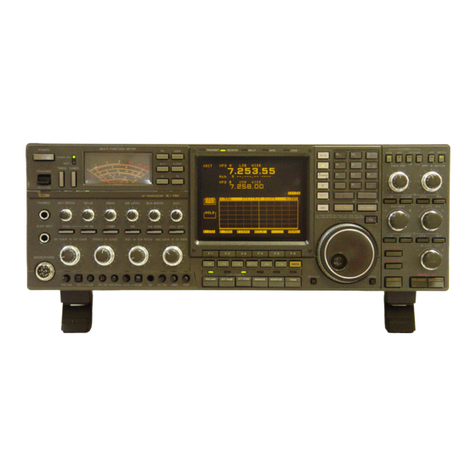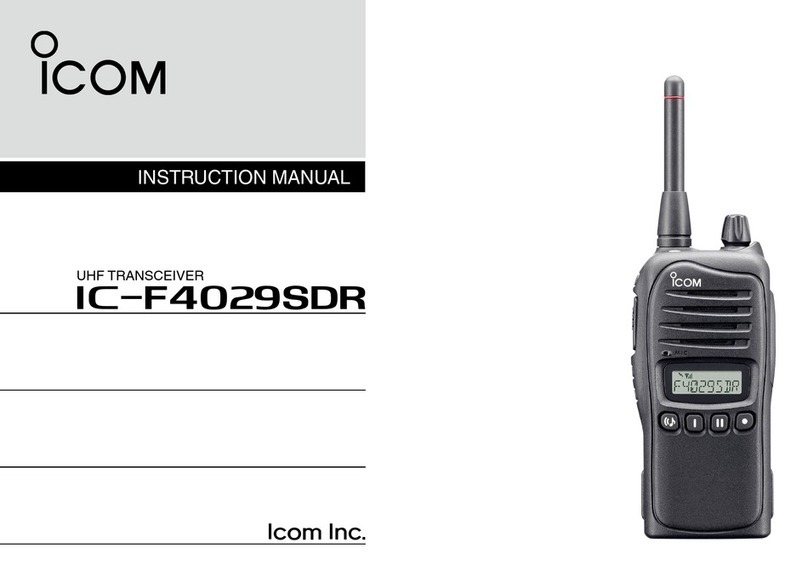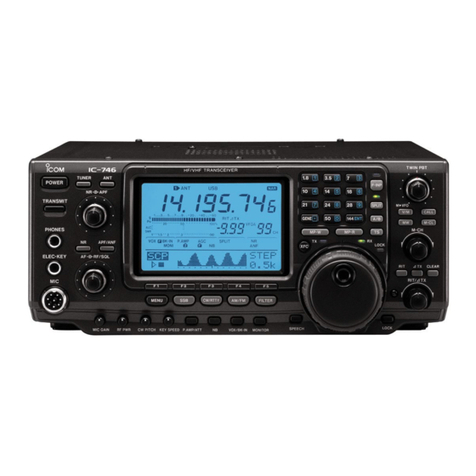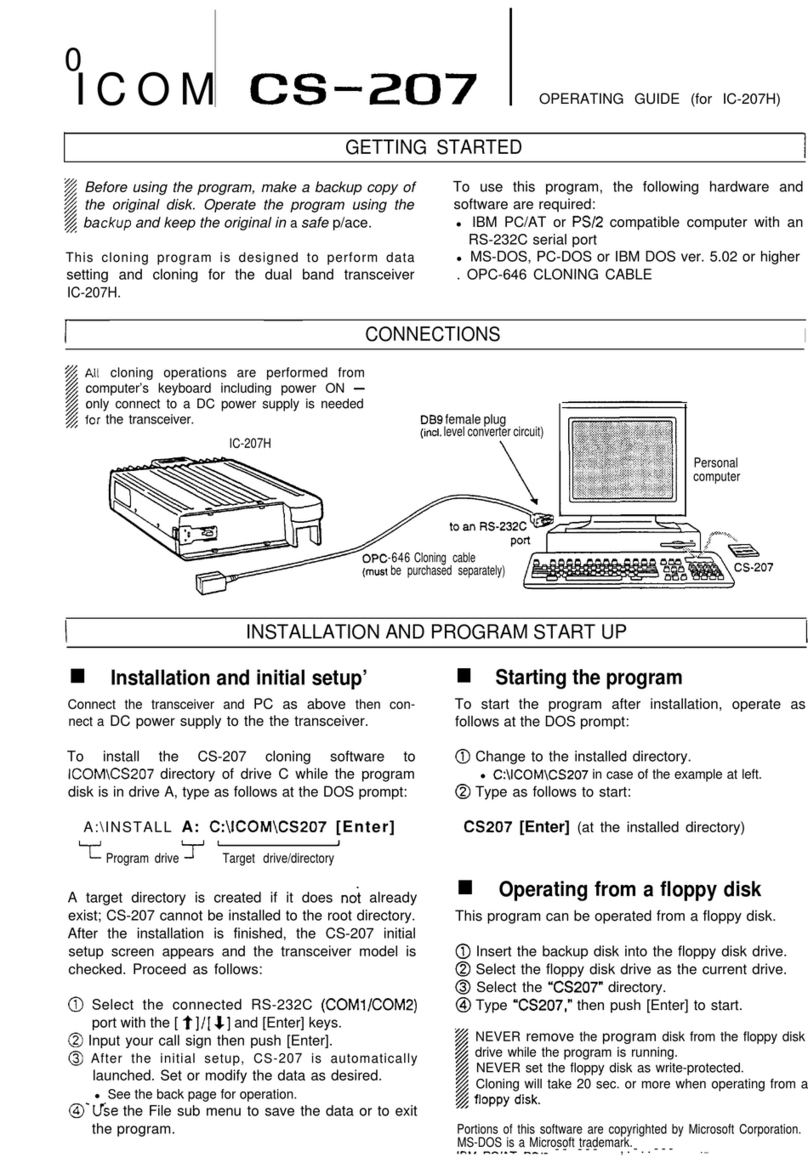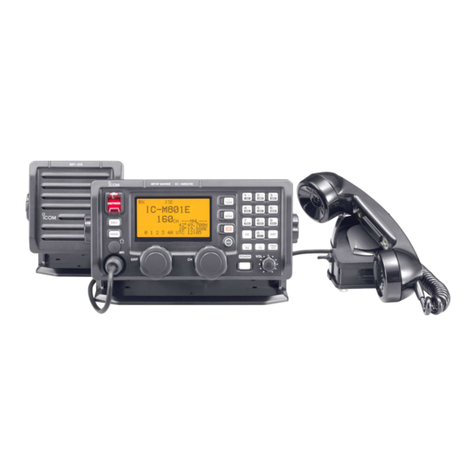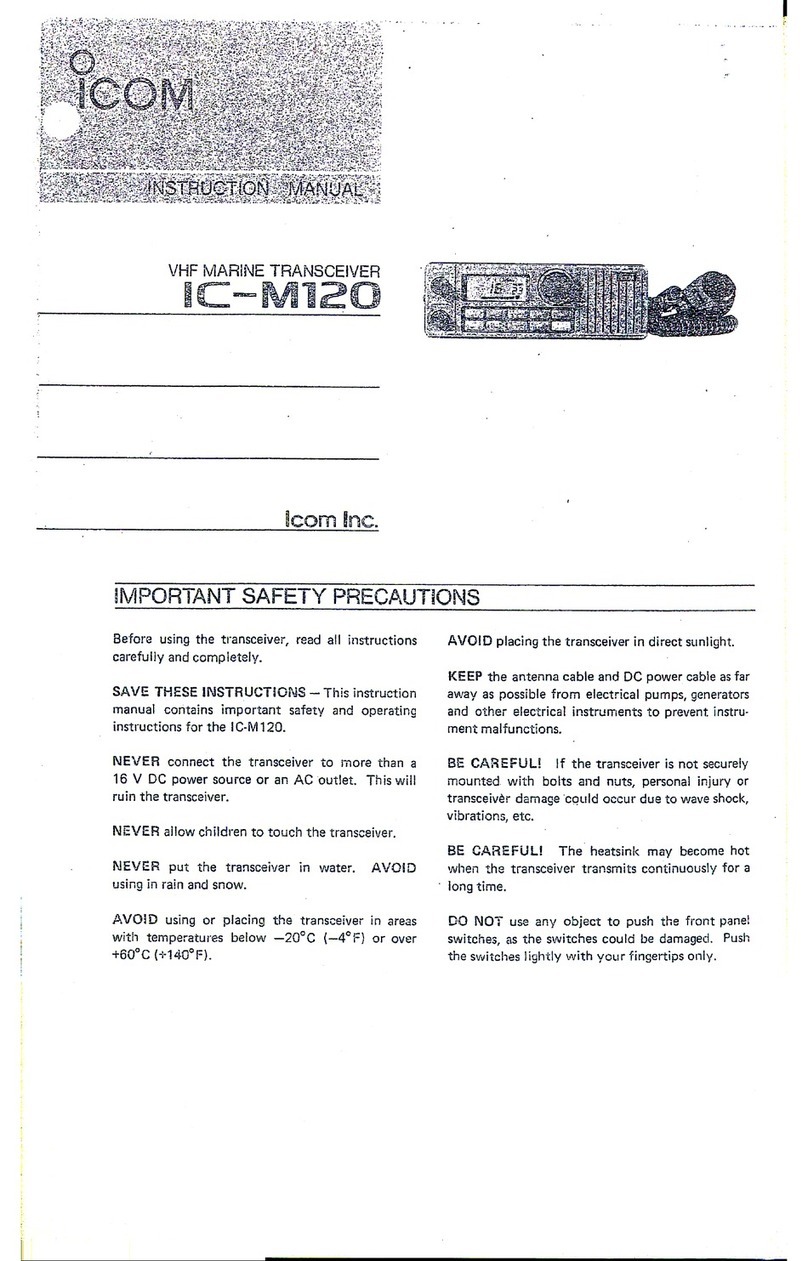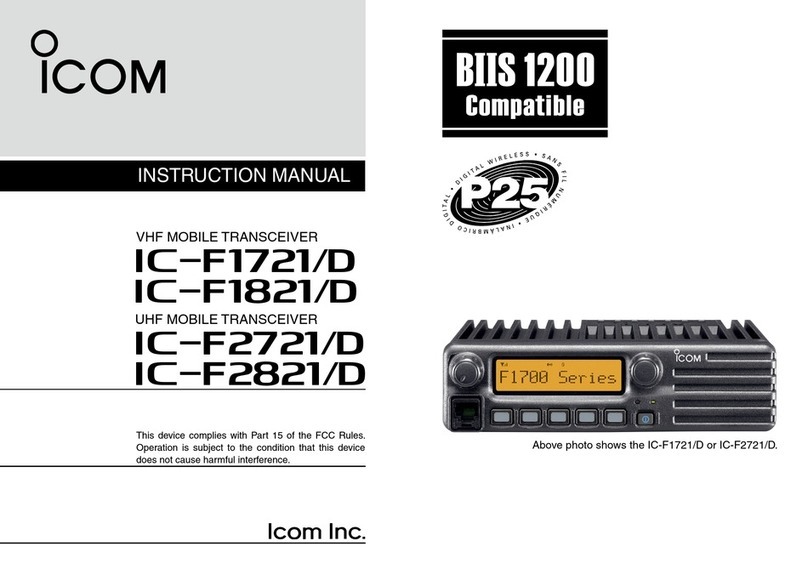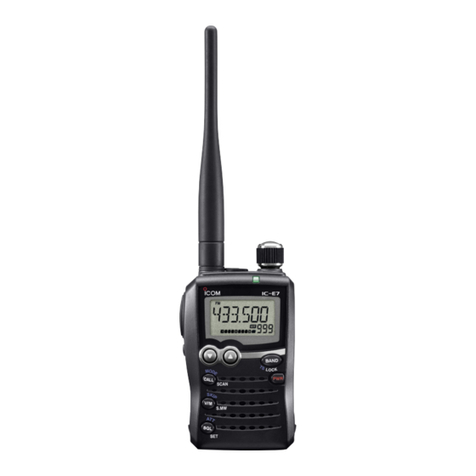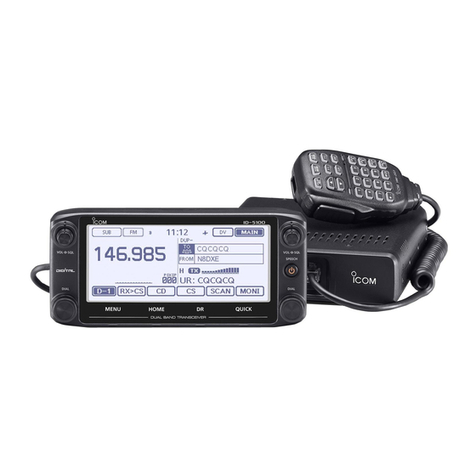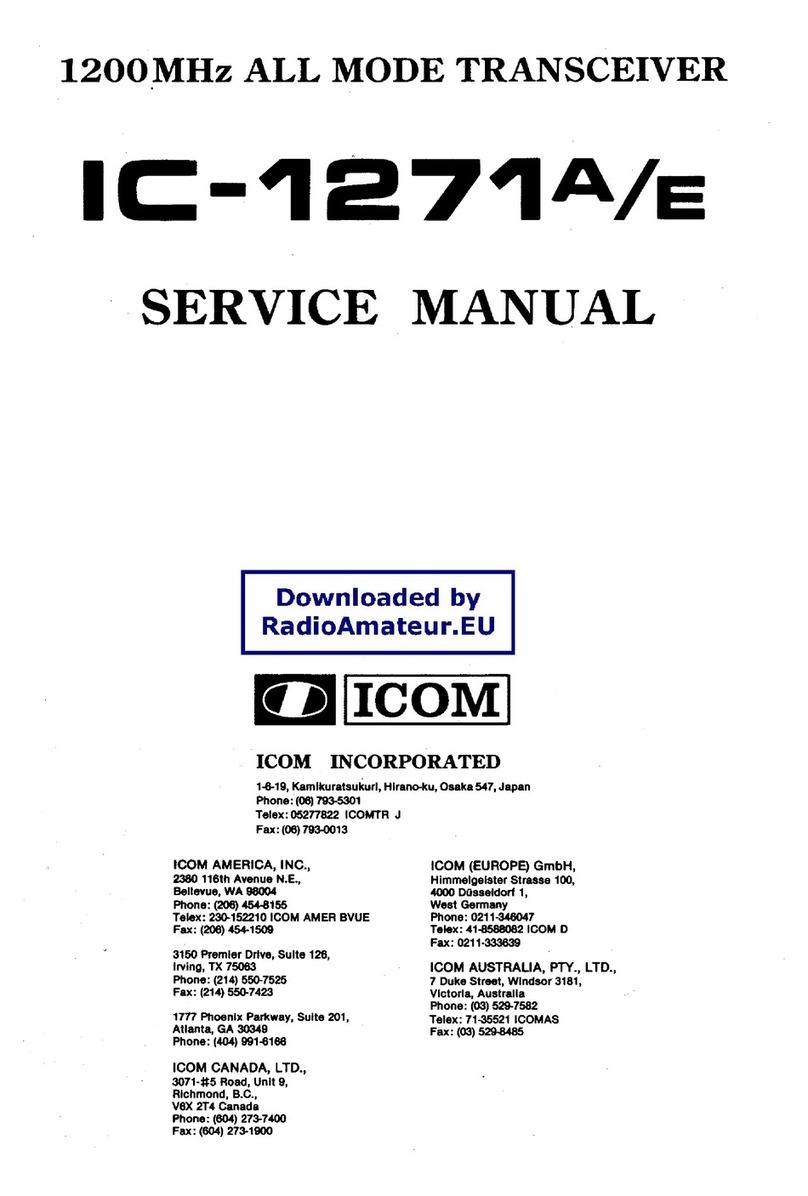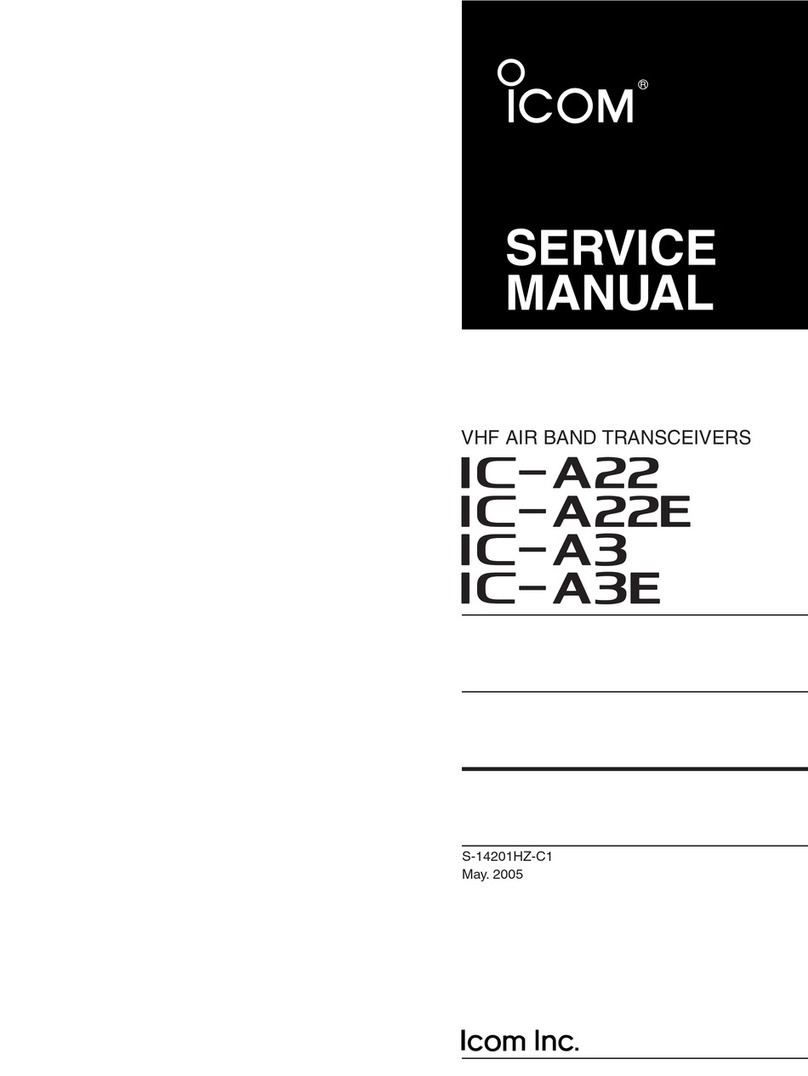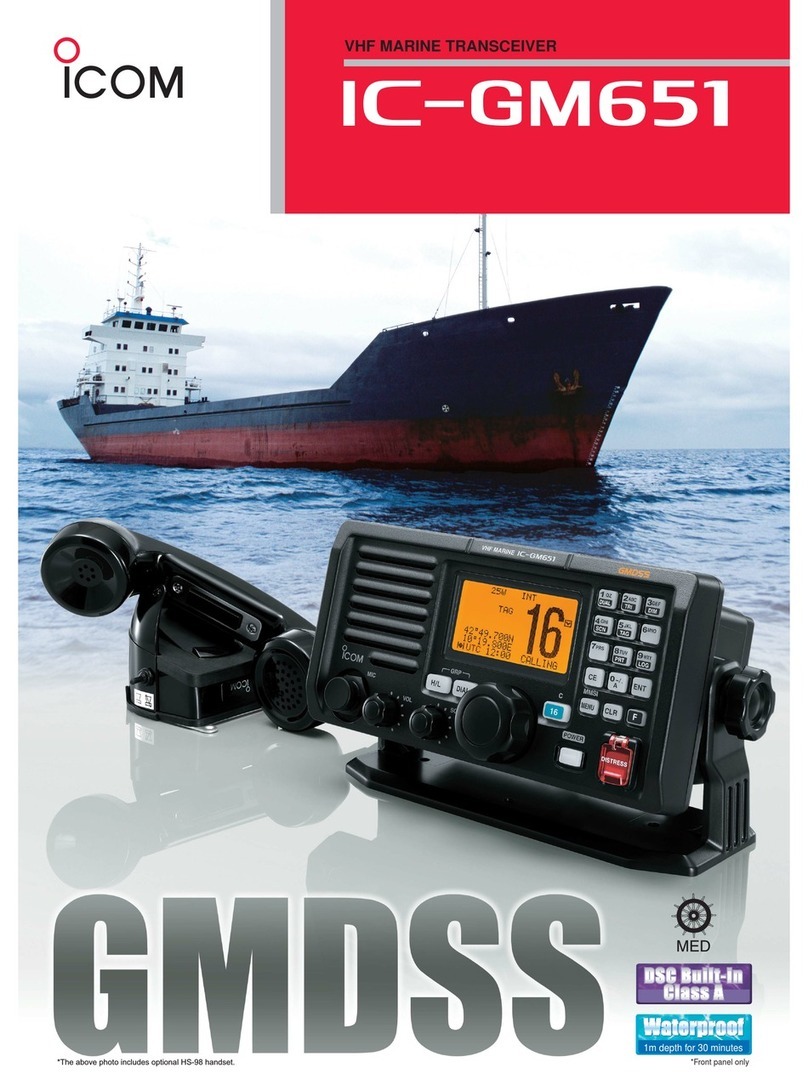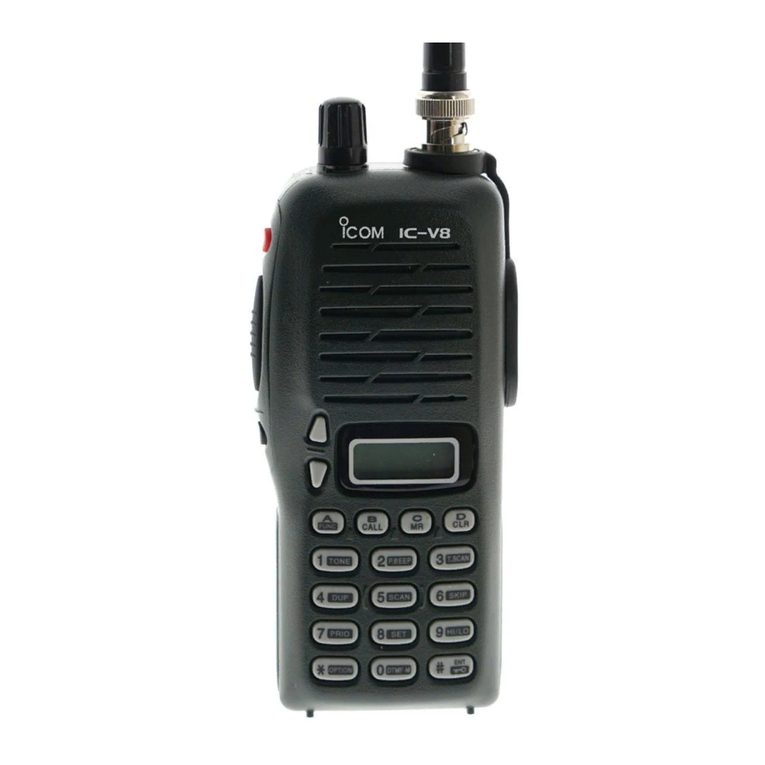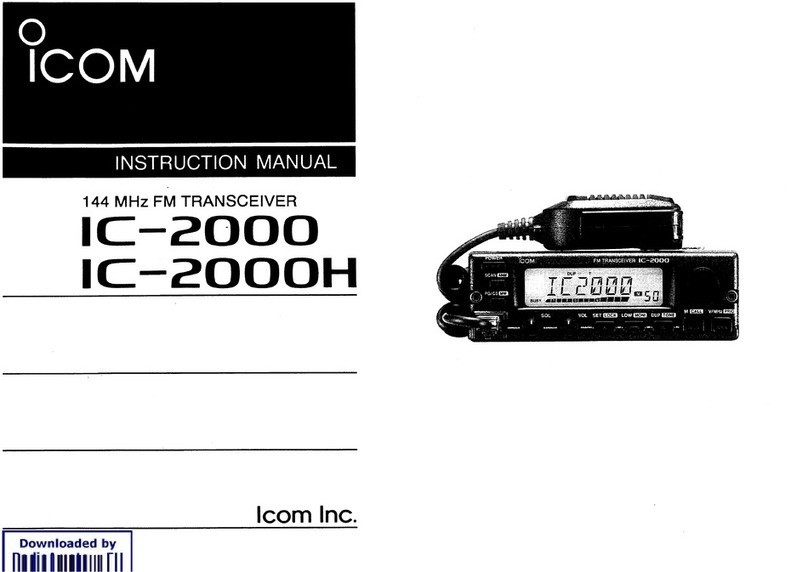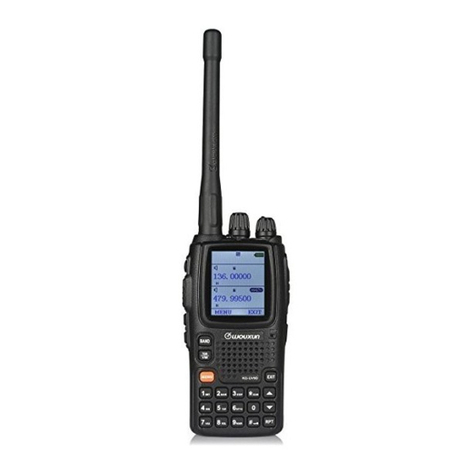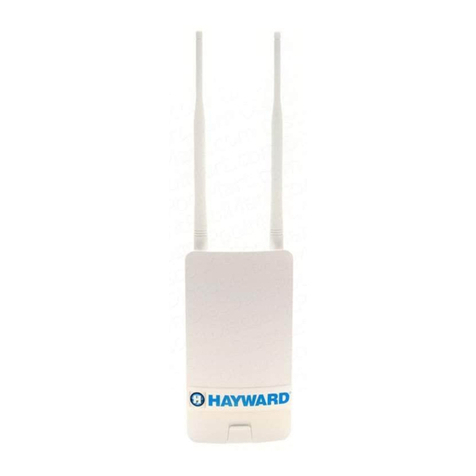Icom IC-F3262DT User manual

OPERATING GUIDE
OPERATING GUIDE FOR
IC-F3262DT/DS
IC-F4262DT/DS
BIIS 1200 SYSTEM/
IDAS
™
dPMR
™
OPERATION

i
Thank you for purchasing this Icom transceiver.
The Binary Interchange of Information and Signaling (BIIS)
1200 and digital Private Mobile Radio (dPMR) system func-
tions are built into your IC-F3262DT/DS or IC-F4262DT/DS
transceiver.
READ ALL INSTRUCTIONS carefully and completely
before using the transceiver.
SAVE THIS OPERATING GUIDE — This guide con-
tains important operating instructions for:
• IC-F3262DT/DS v h f dp m r h a n d h e l d t r a n s c e i v e r
• IC-F4262DT/DS u h f dp m r h a n d h e l d t r a n s c e i v e r
NOTE: In this operating guide, the LCD illustration is
shown as having characters displayed in two lines.
Icom, Icom Inc. and the Icom logo are registered trademarks of Icom Incor-
porated (Japan) in Japan, the United States, the United Kingdom, Germany,
France, Spain, Russia and/or other countries.
IDAS and IDAS logo are trademarks of Icom Incorporated (Japan).
dPMR and the dPMR logo are trademarks of the dPMR MoU Association.
All other products or brands are registered trademarks or trademarks of their
respective holders.
IMPORTANT

TABLE OF CONTENTS
ii
IMPORTANT.......................................................................... i
TABLE OF CONTENTS........................................................ ii
1 PREPARATION............................................................1–2
■ Programmable function keys........................................1
2 BIIS 1200 OPERATION .............................................3–12
■ BIIS 1200 operation......................................................3
■ BIIS display ..................................................................3
■ Receiving a call ............................................................3
■ Transmitting a call.........................................................7
■ Position data transmission..........................................11
■ Stun function ..............................................................11
■ Man Down Emergency Call........................................11
■ BIIS ANI .....................................................................12
■ Printer connection ......................................................12
3 dPMR OPERATION.................................................13–27
■ dPMR operation .........................................................13
■ dPMR display .............................................................13
■ Receiving a call ..........................................................13
■ Transmitting a call.......................................................18
■ Transmitting a command ............................................24
■ Position data transmission..........................................26
■ Man Down Emergency Call........................................26
■
Status message transmission .....................................27
■ Printer connection ......................................................27

1
1PREPARATION
■Programmable function keys
The following functions can be assigned to [EMR], [Side1],
[Side2], [Side3], [P0], [P1], [P2] and [P3] programmable
function keys.
Consult your Icom dealer or system operator for details con-
cerning your transceiver’s programmed keys and their func-
tions.
If the programmable function names are bracketed in the fol-
lowing explanations, the specific key is used to activate the
function.
DFor only BIIS 1200 operation
The following key function is required for BIIS 1200 operation.
BIIS BUTTON “BIIS”
➥Push to enter the call code memory mode.
• Push [CH Up] or [CH Down] to select a desired Individual or
Group ID.
➥While in the call code memory mode, push to enter the
message selection mode.
• Push [CH Up] or [CH Down] to select a desired status message
or Short Data Message (SDM).
➥
While in the message selection mode, push
to return to the
stand-by mode.
➥Hold down for 1 second to toggle between the memory
channel mode and the queue channel mode.
➥While in the queue channel mode, push to toggle between
the queue channel mode and the received message
mode.
DFor only dPMR operation
The following key functions are required for dPMR operation.
dPMR BUTTON “dPMR”
➥Push to enter the ID selection mode.
• Push [CH Up] or [CH Down] to select a desired Individual or
Talkgroup ID.
➥While in the ID selection mode, push to enter the application
selection mode.
• Push [CH Up] or [CH Down] to select a desired application from
“STATUS,” “MESSAGE,” “STAT POL,” “LISTENING,” “STUN,”
“KILL,” “REVIVE” and “CALL LOG.”
➥If you select “STATUS” or “MESSAGE”in the application selec-
tion mode, push to enter the message selection mode.
• Push [CH Up] or [CH Down] to select a desired message.
➥
While in the application selection mode, push
to return to
the stand-by mode.
CLEAR “CLR”
After communication is finished, push this key to send a ‘Dis-
connect’ signal to terminate the connection.
Depending on the preprogrammed settings, the Priority A
channel is automatically selected after a ‘Disconnect’ sig-
nal terminates a connection.

DFor both BIIS 1200 and dPMR operations
The following key functions are useful for BIIS 1200 and dPMR
operations.
STATUS UP, STATUS DOWN “STUP” “STDN”
➥Push to select a status message.
➥When the automatic scroll function is activated, push to
cancel it, if desired.
➥When an SDM that includes more than 12 characters is
displayed, push to manually scroll the message.
STATUS “STAT”
➥Push to enter the status message selection mode.
• Push [CH Up] or [CH Down] to select a desired message.
➥
Hold down for 1 second to transmit the last selected status
message.
MESSAGE “MSG”
➥Push to enter the SDM selection mode.
• Push [CH Up] or [CH Down] to select a desired SDM.
➥While in the SDM selection mode, hold down for 1 second
to transmit the last selected SDM.
➥While in the stand-by mode, hold down for 1 second to
enter the message editing mode. (dPMR only)
•
Set a desired message using the 10-keypad. (Only 10-key version)
(p.22)
In BIIS 1200 operation, status messages and SDM are
selectable in the same mode.
DAdditional key functions
• For both BIIS 1200 and dPMR operations
The following key functions are recommended for BIIS 1200
and dPMR operations, and function as described below.
CALL “CALL”
➥On an MSK channel, push to transmit a BIIS call.
➥On a digital channel, push to transmit a dPMR call.
Depending on the preprogrammed settings, pushing [PTT]
makes a call in the same way as using [Call]. Moreover,
when you keep holding down [PTT] after receiving an
acknowledgement, you can start a conversation without
pushing it again.
TX CODE ENTER “TXCE”
Push to enter the ID code edit mode, and then set a desired
ID code. (pp. 7, 18)
• For only BIIS 1200 operation
The following key function is required for BIIS 1200 operation,
and functions as described below.
MONITOR (AUDIBLE) “MON”
After communication is finished, push this key to send a ‘Clear
down’ signal to terminate the connection.
Depending on the preprogrammed settings, the Priority A
channel is automatically selected after a ‘Clear down’ sig-
nal terminates a connection.
2
1
PREPARATION
1
2
3
4
5
6
7
8
9
10
11
12
13
14
15
16

3
2BIIS 1200 OPERATION
■BIIS 1200 operation
The Binary Interchange of Information and Signalling (BIIS)
1200 standard is the best choice to add a data service to an
existing system. It enables digital communications, signalling
and message exchanges with analog transceivers.
The BIIS system provides calling features such as Individual,
Group, and Emergency calls, as well as enables receiving
and transmitting status messages and SDM.
NOTE: During BIIS 1200 operation, dPMR operation is
disabled.
■BIIS display
The following displays appear in BIIS 1200 operation.
CONNECT : When an acknowledgement of an Individual or
Group call is received.
OK : When an acknowledgement of a message (sta-
tus message or SDM) is received.
FAILED : When no acknowledgement of a call is re-
ceived.
WAIT : While transmitting.
CLR DOWN : When a connection is terminated.
BUSY : When the operating channel is busy.
■Receiving a call
DReceiving an Individual call
When an Individual call is received:q
• Rings sound.
• “ ” appears and the mute is released.
• “ ” appears or blinks, depending on the preprogrammed set-
tings.
• Your own ID (or name) and the calling station’s ID (or name)
blink.
w While holding down [PTT], speak into the microphone at
your normal voice level.
Releasee[PTT] to receive.
r After the communication is finished, push [Moni (Audi)] to
send a ‘Clear down’ signal to terminate the connection.
• Either you or the calling station can send a ‘Clear down’ signal.
• “ ” disappears, “CLR DOWN” appears for approximately 2 sec-
onds, and the transceiver automatically returns to the stand-by
mode.
BIIS CALL
Appears Appears or blinks
TXCE MON
1234
0001
Calling station’s ID
Your own ID

4
2
BIIS 1200 OPERATION
1
2
3
4
5
6
7
8
9
10
11
12
13
14
15
16
DReceiving a Group call
When a Group call is received:q
• Rings sound.
• “ ” appears and the mute is released.
• “ ” appears or blinks, depending on the preprogrammed set-
tings.
• The group ID (or name) and the calling station’s ID (or name)
blink.
w While holding down [PTT], speak into the microphone at
your normal voice level.
NOTE: Only one station is allowed to speak at the
same time.
Releasee[PTT] to receive.
r After the communication is finished, push [Moni (Audi)] to
send a ‘Clear down’ signal to terminate the connection.
• Either station can send a ‘Clear down’ signal.
• “ ” disappears, “CLR DOWN” appears for approximately 2 sec-
onds, and the transceiver automatically returns to the stand-by
mode.
DReceiving an Emergency call
When an Emergency call is received:q
• Rings sound.
• “Emergency” and the calling station’s ID (or name) blink.
• The transceiver automatically transmits an acknowledgement to
the calling station.
Pushw[Moni (Audi)] to return to the stand-by mode.
BIIS CALL TXCE CLR
1234
4001
Calling station’s ID
Group ID
Appears Appears or blinks
BIIS CALL TXCE MON
1234
Calling station’s ID
Emergency

5
2BIIS 1200 OPERATION
■Receiving a call (continued)
DReceiving a status message
When a status message is received:q
• Rings sound.
• The calling station’s ID (or name) and the status message blink.
Pushw[Moni (Audi)] to return to the stand-by mode.
NOTE: When the display mode is one line
If the ‘Scroll Timer’ item is set to “OFF,” even when a sta-
tus message is received, only the calling station’s ID (or
name) is displayed (no message is alternately displayed).
In that case, push [Status Down] to display the status
message manually.
DReceiving an SDM
When an SDM is received:q
• Rings sound.
• The calling station’s ID (or name) and the SDM blink.
NOTE: When the SDM includes more than 12 charac-
ters, it automatically scrolls.
• Push [Status Up] or [Status Down] to stop scrolling, or
manually scroll the message.
• “ ” appears.
Pushw[Moni (Audi)] to return to the stand-by mode.
BIIS CALL TXCE MON
1234
RX Status 01
Calling station’s ID
The received
status message
BIIS CALL TXCE MON
1234
The received SDM
Message 1
Calling station’s ID
BIIS CALL TXCE MON
1234
RETURN
TO
OFFICE
Scrolls

6
2
BIIS 1200 OPERATION
1
2
3
4
5
6
7
8
9
10
11
12
13
14
15
16
DDisplaying a received call record
— Queue channel mode
The transceiver memorizes up to three calling station’s IDs.
When the fourth call is received, the oldest call record will be
removed, and the last received call will be added. When the
transceiver is turned OFF, all the records are deleted.
Hold downq[BIIS Button] for 1 second to enter the queue
channel mode.
• The screen display varies as shown below.
Pushw[CH Up] or [CH Down] to display a desired record.
Hold downe[BIIS Button] for 1 second again to return to
the stand-by mode.
• When no operation occurs for 30 seconds, the transceiver auto-
matically returns to the stand-by mode.
NOTE: You can call back from the queue channel record.
While displaying an ID, push [Call] to make a call using
the selected ID.
DDisplaying a received message
The transceiver memorizes up to six received messages.
When the seventh message is received, the oldest mes-
sage will be removed, and the last received message will be
added. When the transceiver is turned OFF, all the messages
are deleted.
Hold downq[BIIS Button] for 1 second to enter the queue
channel mode.
w Push [BIIS Button] momentary to enter the received mes-
sage mode.
• The screen display varies as shown below.
Pushe[CH Up] or [CH Down] to display a desired mes-
sage.
Hold downr[BIIS Button] for 1 second again to return to
the stand-by mode.
• When no operation occurs for 30 seconds, the transceiver auto-
matically returns to the stand-by mode.
BIIS CALL TXCE MON
<
QUEUE
>
–QUEUE!–
BIIS CALL TXCE MON
<
QUEUE
>
NO QUEUE
When the transceiver
has a call record
When the transceiver
has no call record
When the transceiver
has a message record
When the transceiver
has no message record
BIIS CALL TXCE MON
MESSAGE
−
MSG!
−
BIIS CALL TXCE MON
MESSAGE
−
NO MSG
−

7
2BIIS 1200 OPERATION
■Transmitting a call
DGeneral
• Editing an ID
If the transceiver has a key assigned to the TX Code Enter
function, you can edit an ID within the allowable digits.
Pushq[TX Code Enter] to enter the ID edit mode.
• The digit to be edited blinks.
wPush [TX Code Enter] to select a desired digit to be ed-
ited.
e Push [CH UP] or [CH DOWN] to select a desired num-
ber.
Pushr[TX Code Enter] to set. The digit to the right will
automatically blink.
Repeat stept e and rto input all allowable digits.
After editing, pushy[TX Code Enter] to store the setting.
• The transceiver returns to the standby mode.
NOTE: To overwrite the original ID, set the ‘Update’ item
to “Enable” using the CS-F3160/F5060 (dPMR) cloning
software.Otherwise, changing the channel or turning
OFF the transceiver discards the new ID, and returns the
original one. Ask your dealer for details.
DTransmitting an Individual or Group call
NOTE: If you want to make a call to the preprogrammed
ID, skip step qand wthen directly go to step e.
Pushq[BIIS Button] to enter the call code memory mode.
• The preprogrammed ID is displayed.
• “ ” appears.
wPush [CH Up] or [CH Down] to select a desired Individual
ID or Group ID.
Pushe[Call] to make a call.
• “WAIT” appears while transmitting.
• “ CONNECT” is displayed when an acknowledgement is received.
NOTE: If no acknowledgement is received, the trans-
ceiver automatically repeats the call three times (de-
fault). However, when no acknowledgement is received
after each of the calls, an error beep sounds and
“FAILED” is displayed. In that case, the transceiver au-
tomatically returns to the stand-by mode.
r After “CONNECT” is displayed, hold down [PTT] and
speak into the microphone at your normal voice level. Re-
lease [PTT] to receive.
tAfter the communication is finished, push [Moni (Audi)] to
send a ‘Clear down’ signal to terminate the connection.
BIIS CALL TXCE MON
1234
Appears

8
2
BIIS 1200 OPERATION
1
2
3
4
5
6
7
8
9
10
11
12
13
14
15
16
DTransmitting a status message
You can send a preprogrammed status message to an indi-
vidual station or to group stations.
There are 24 status messages that can be sent, and Status
22 and 24 messages have designated meanings.
Status 22: Emergency
Status 24: GPS request
• Status 22 can also be used as a normal status message by
disabling the designated meaning. However, Status 24 is fixed.
NOTE: Depending on the preprogrammed settings, the
Priority A channel is always used to send status mes-
sages.
Pushq[BIIS Button] to enter the call code memory mode.
• “ ” appears.
• The preprogrammed ID is displayed.
w Push [CH Up] or [CH Down] to select a desired Individual
ID or Group ID.
e Push [BIIS Button] again to enter the message selection
mode, then push [CH Up] or [CH Down] to select a de-
sired status message.
r Push [Call] to transmit the status message to the selected
station or group.
• “WAIT” is displayed while transmitting.
• “OK” is displayed when an acknowledgement is received.
• “FAILED” is displayed when no acknowledgment is received.
t After a specified time period, the transceiver will return to
the stand-by mode.
BIIS CALL TXCE MON
TX
Status
01
STATUS 01
A status message is displayed.

9
2BIIS 1200 OPERATION
■Transmitting a call (continued)
DTransmitting an SDM
You can send a preprogrammed SDM to an individual station
or to group stations.
The transceiver has eight memories to store messages.
Pushq[BIIS Button] to enter the call code memory mode.
• “” appears.
• The preprogrammed ID is displayed.
Pushw[CH Up] or [CH Down] to select a desired Individual
ID or Group ID.
e Push [BIIS Button] again to enter the message selection
mode, then push [CH Up] or [CH Down] to select a de-
sired SDM.
r Push [Call] to transmit the SDM to the selected station or
group.
• “WAIT” is displayed while transmitting.
• “OK” is displayed when an acknowledgement is received.
• “FAILED” is displayed when no acknowledgment is received.
After a specified time period, the transceiver will return tot
the stand-by mode.
DDirect message input (Only 10-key version)
While displaying an SDM, you can edit or change the mes-
sage.
Pushq[BIIS Button] twice to enter the message selection
mode, then push [CH Up] or [CH Down] to select a de-
sired SDM.
Pushw[M]or [#] to enter the message editing mode.
• The first character blinks when [#] is pushed, the last character
blinks when [M]is pushed.
e Push the appropriate digit key, [0] to [9], to enter a desired
character.
• See the table on the next page for the usable characters.
• Push [CH Up] to enter a space, and push [CH Down] to delete
the selected character.
r Push [#] or wait for the timeout period to move the cursor
to the right, push [M]to move the cursor to the left.
• After the preprogrammed period has past, the cursor automati-
cally moves to the right.
t Repeat steps eand rto enter a message of up to 12
characters.
y Hold down [BIIS Button] for 1 second to write the new
programmed message into the SDM memory.
• Push [BIIS Button] momentarily to cancel editing and return to
the original message display.
BIIS CALL TXCE MON
SDM 1
MESSAGE 1
An SDM is displayed.

10
2
BIIS 1200 OPERATION
1
2
3
4
5
6
7
8
9
10
11
12
13
14
15
16
• Usable characters
NOTE: Messages can be edited also using a PC editing
program. Ask your dealer for details.
DTransmitting an Emergency call
If an MSK channel is used as the Emergency channel, the
transceiver can access the BIIS emergency mode.
If your transceiver is programmed for Silent operation, you
can transmit Emergency calls without the beep sounding or
the display changing.
q Hold down [Emergency] for the preprogrammed time pe-
riod to enter the emergency mode.
• Countdown beeps start.
• To exit the emergency mode, hold down [Emergency] for the
preprogrammed period before the end of the count-down time
period.
When the time period ends, the transceiver automaticallyw
starts an Emergency call cycle, once or repeatedly, de-
pending on the preprogrammed repeat cycle setting.
e In an Emergency call cycle, the transceiver automatically
transmits Status 22 (Emergency) to inform the dispatcher
that the user is in an emergency situation.
• “WAIT” appears while transmitting.
• “OK” is displayed when an acknowledgement is received.
• “FAILED” is displayed when no acknowledgment is received.
NOTE: Depending on the preprogrammed settings, the
transceiver does not transmit Status 22 in the repeated
cycles.
r After the Emergency call cycles have ended, the trans-
ceiver automatically returns to the stand-by mode.
• To exit the emergency mode manually, turn OFF the power, and
turn ON it again.
Key Characters
[0]
[1]
[2]
[3]
[4]
[5]
[6]
[7]
[8]
[9]
2BAabcC
3EDdefF
4HGghiI
5KJjklL
6NMmnoO
7QPSpq rsR
9XWZwxyzY
8UTtuvV
(space)
1^@# �/–=\&% $+
0][!’”,?:_()<>;
|

11
2BIIS 1200 OPERATION
■Position data transmission
Only transceiver versions with the GPS unit installed can
transmit position data.
The longitude and latitude position data can be automatically
transmitted when:
• When Status 24 (GPS request) is received.
• When [PTT] is released.
- Set the ‘Send with Logoff’ item to “Enable.”
• After sending a status message.
- Set the ‘Send with Status’ item to “Enable.”
• After sending an SDM.
- Set the ‘Send with SDM’ item to “Enable.”
• After sending Status 22 (Emergency).
- Set the ‘Send with Emergency’ item to “Enable.”
• After sending an Emergency call with the Man Down func-
tion.
- Set the ‘Send at ManDown’ item to “Enable.”
• By the Automatic Position Data Transmission function.
When the function is activated, the transceiver auto-
matically transmits position data according to the ‘Time
Marker’ and ‘Interval Timer’ settings.
- Set the ‘Auto’ item to “Enable.”
■Man Down Emergency Call
Depending on the transceiver’s version, this function is not
available.
When the transceiver has been left in a horizontal position
for a specified time period*, the transceiver enters the emer-
gency mode, and then a countdown starts.
After the specified time period* has passed, an emergency
call is automatically transmitted once, or repeatedly. (See the
previous page for details.)
If the transceiver is placed in a vertical position before the
first transmission, the transceiver exits the emergency mode
and the emergency call is cancelled.
* Depending on the presetting. Ask your dealer for details.
■Stun function
If a call is received with a specified ID, set as the killer ID, the
stun function is activated and the transceiver is disabled. In
that case, entering the password is necessary to reactivate
the transceiver.

12
2
BIIS 1200 OPERATION
1
2
3
4
5
6
7
8
9
10
11
12
13
14
15
16
■BIIS ANI
Your own ID can be transmitted each time [PTT] is pushed
(log-in) or released (log-off) during Individual or Group call
communications.
By receiving an ANI, the communication log can be recorded
when using a PC dispatch application.
In addition, when using the ANI with the Log-in function, the
PTT Side Tone function can be used to inform you that the ID
is sent and communication can begin.
■Printer connection
When the OPC-1862 optional cable is connected to the trans-
ceiver, a printer can be connected to print out the received
SDM content and the ID of the station that sent the mes-
sage.
Ask your dealer or system operator for connection details.

■dPMR operation
The IC-F3262DT/IC-F3262DS and IC-F4262DT/IC-F4262DS
provide digital Private Mobile Radio (dPMR) operation that
meets the 6.25 kHz bandwidth requirements for narrow band
operation. This increases the efficiency of channel allocation
and use of the spectrum.
NOTE: During dPMR operation, BIIS 1200 operation is
disabled.
■dPMR display
The following displays appear in dPMR operation.
CONNECT : When an acknowledgement of a Voice or Emer-
gency call is received.
OK : When an acknowledgement of a message (sta-
tus message or SDM) or command (Ambience
Listening, Stun, Kill, or Revive) is received.
FAILED : When no acknowledgement of a call is re-
ceived.
WAIT : While transmitting.
CLR DOWN : When a connection is terminated.
ID : When no name is programmed, appears to the
left of the calling station’s ID.
TG : When no name is programmed, appears to the
left of the Talkgroup ID.
■Receiving a call
DReceiving an Individual call
When an Individual call is received:q
• Rings sound.
• “ ” appears and the mute is released.
• “ ” appears or blinks, depending on the preprogrammed set-
tings.
• The calling station’s ID (or name) blinks.
w While holding down [PTT], speak into the microphone at
your normal voice level.
Releasee[PTT] to receive.
r After the communication is finished, push [Clear] to send
a ‘Disconnect’ signal to terminate the connection.
• Either station can send a ‘Disconnect’ signal.
• “ ” disappears, “CLR DOWN” appears for approximately 2 sec-
onds, and the transceiver automatically returns to the stand-by
mode.
13
3dPMR OPERATION
Appears Appears or blinks
dPMR CALL TXCE CLR
ID 0000001
Calling station’s ID
PRIVAT E
The received individual call

14
3
dPMR OPERATION
1
2
3
4
5
6
7
8
9
10
11
12
13
14
15
16
DReceiving a Group call
When a Group call is received:q
• Rings sound.
• “ ” appears and the mute is released.
• “ ” appears or blinks, depending on the preprogrammed set-
tings.
• The Talkgroup ID (or name) and the calling station’s ID (or name)
blink.
• When an All Call is received, “ALL CALL” blinks instead of “TG”
and the Talkgroup ID.
w While holding down [PTT], speak into the microphone at
your normal voice level.
NOTE: Only one station is allowed to speak at the
same time.
Releasee[PTT] to receive.
r After the communication is finished, push [Clear] to send
a ‘Disconnect’ signal to terminate the connection.
• Either station can send a ‘Disconnect’ signal.
• “ ” disappears, “CLR DOWN” appears for approximately 2 sec-
onds, and the transceiver automatically returns to the stand-by
mode.
DReceiving a status message
When a status message is received:q
• Rings sound.
• The calling station’s ID (or name) and the status message
blink.
Pushw[Clear] to return to the stand-by mode.
dPMR CALL TXCE CLR
ID
0000001
TG
0100000
Calling station’s ID
Talkgroup ID
Appears Appears or blinks
dPMR CALL TXCE CLR
ID 0000001
R
X Status 00
Calling station’s ID
The received
status message

15
3dPMR OPERATION
■Receiving a call (continued)
DReceiving an SDM
When an SDM is received:q
• Rings sound.
• The calling station’s ID (or name) and the SDM are displayed.
NOTE: When the SDM includes more than 12 charac-
ters, it automatically scrolls.
• Push [Status Up] or [Status Down] to stop scrolling, or
manually scroll the message.
• “ ” appears.
Pushw[Clear] to return to the stand-by mode.
DReceiving a Stun, Kill or Revive call
If an Individual call with a Stun or Kill command is received
from a specied station, the transceiver will display “SORRY,”
and becomes unusable.
NOTE: If the transceiver receives a Stun, Kill, or Revive
command from a station other than the specified ones,
the call will be ignored, and the transceiver will not be
stunned, killed, or revived.
➥When a Stun command is received, the transceiver is disa-
bled*1. In that case, receiving a Revive command or input-
ting the password*2is necessary to operate the transceiver
again.
*
1Depending on the preprogrammed settings, receiving a Stun
command inhibits only transmission, but the transceiver still can
receive.
*
2Depending on the preprogrammed settings.
➥When a Kill command is received, the transceiver is disa-
bled. In that case, re-programming the transceiver is nec-
essary to operate the transceiver again.
DReceiving a Status Polling call
If a Status Polling call is received, the transceiver will auto-
matically transmit its current status.
dPMR CALL TXCE CLR
ID 0000001
Message 1
Calling station’s ID
The received
message
dPMR CALL TXCE CLR
ID 0000001
RETURN
TO
OFFICE
Scrolls

16
3
dPMR OPERATION
1
2
3
4
5
6
7
8
9
10
11
12
13
14
15
16
DReceiving an Ambience Listening call
If an Individual call with an Ambience Listening command is
received from a specified station, the transceiver will auto-
matically transmit its microphone audio.
NOTE: If the transceiver receives an Ambience Listening
command from a station other than the specified one, the
call will be ignored, and the transceiver will not transmit its
microphone audio.
DReceiving an Emergency call
When an Emergency call is received:q
• Rings sound.
• “ Emergency” and the channel number* are alternately dis-
played.
* Depending on the preprogrammed settings, the calling station’s
ID (or name) can be displayed.
• The transceiver automatically transmits an acknowledgement to
the calling station.
Pushw[Clear] to return to the stand-by mode.
DTalk back function
The Talk Back function allows you to select the same call
mode (Analog or Digital) as the received call.
If the received call is a digital signal, the Talk Back function is
activated for Voice and Emergency calls, and depending on
the preprogrammed settings, also for status messages and
SDM.
When the channel type is “Mixed-Digital”
After receiving an analog signal, “ANALOG” is displayed
during the Talk Back timer period, depending on the prepro-
grammed settings.When [PTT] is pushed before or during the
Talk Back timer period, you can transmit an analog signal.
When the channel type is “Mixed-Analog,”“Mixed-Digital”
or “Digital”
After receiving a digital signal, the calling station’s ID or the
Talkgroup ID is displayed until receiving a ‘Disconnect’ sig-
nal, depending on the preprogrammed settings. Even on a
“Mixed-Analog” channel, when [PTT] is pushed before re-
ceiving a ‘Disconnect’ signal, the Talk Back function allows
the transceiver to transmit a digital signal to the ID.
NOTE: When this function is not activated, the transceiver
always transmits analog signals on “Mixed-Analog” chan-
nels, and digital signals on “Mixed-Digital” channels.
• On these channels, the transceiver can receive both analog and
digital signals, regardless of the Talk Back function.
dPMR
Emergency
CALL
002 ch-01
dPMR CALL TXCE CLR

17
3dPMR OPERATION
■Receiving a call (continued)
DDisplaying a received call log entry
Depending on the preprogrammed setting, the transceiver
stores up to 10 call log entries. Individual Voice, Status and
SDM call log entries are stored. When an 11th call is re-
ceived, the oldest call log entry will be removed, and the last
received call will be added. When the transceiver is turned
OFF, all the log entries are deleted.
Pushq[dPMR Button] twice to enter the application selec-
tion mode.
• “STATUS” appears.
Pushw[CH Up] or [CH Down] to select “CALL LOG.”
Pushe[dPMR Button] again to display a call log entry.
Pushr[CH Up] or [CH Down] to display a desired entry.
• If a Status or SDM call log entry is selected, not only the calling
station’s ID but also the status message or message are dis-
played.
Pusht[dPMR Button] again to return to the stand-by
mode.
NOTE: Depending on the preprogrammed settings, push-
ing [Call] while displaying a call log entry makes a Voice
call using the entry’s ID. However, if a Status or SDM call
log entry is selected, the transceiver makes a Voice call
using the last selected Individual or Talkgroup ID.
dPMR CALL TXCE CLR
VOICE
0000001
dPMR CALL TXCE CLR
NO LOG
When the transceiver
has a call log entry
When the transceiver
has no call log entries
Other manuals for IC-F3262DT
2
This manual suits for next models
3
Table of contents
Other Icom Transceiver manuals
Popular Transceiver manuals by other brands
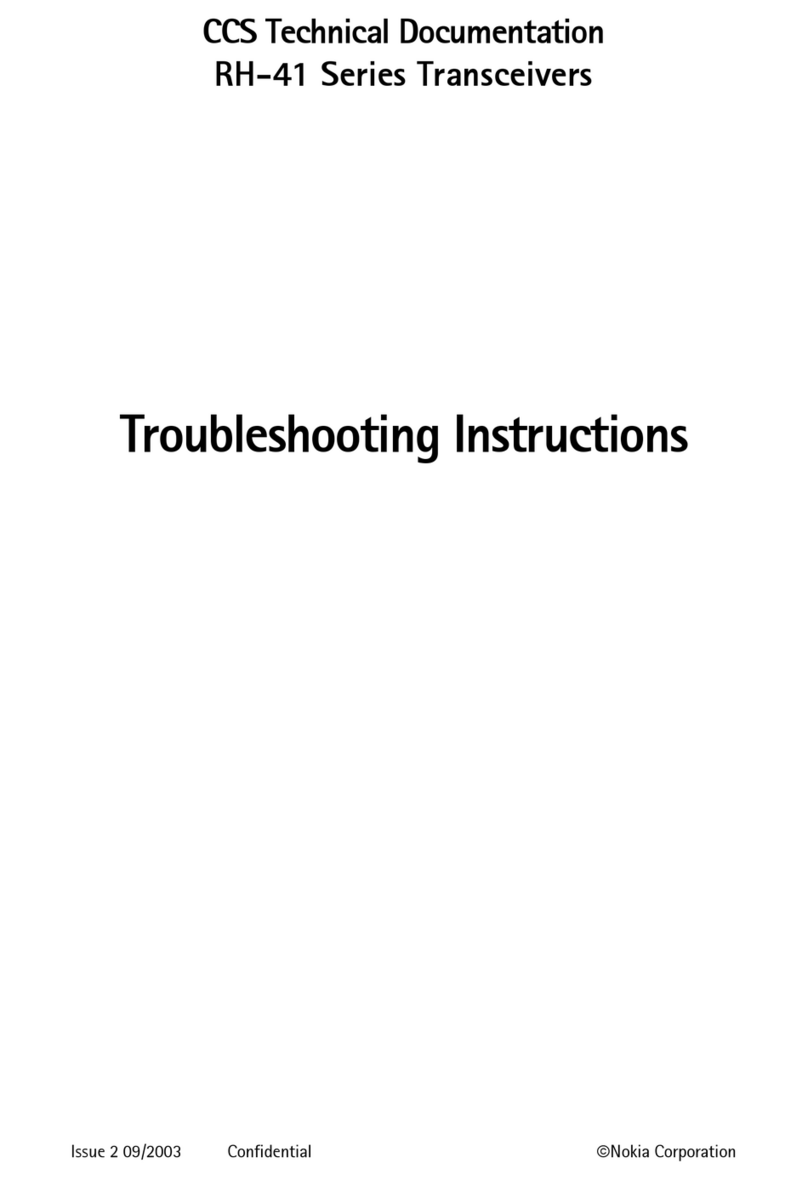
Nokia
Nokia RH-41 Series Troubleshooting instructions
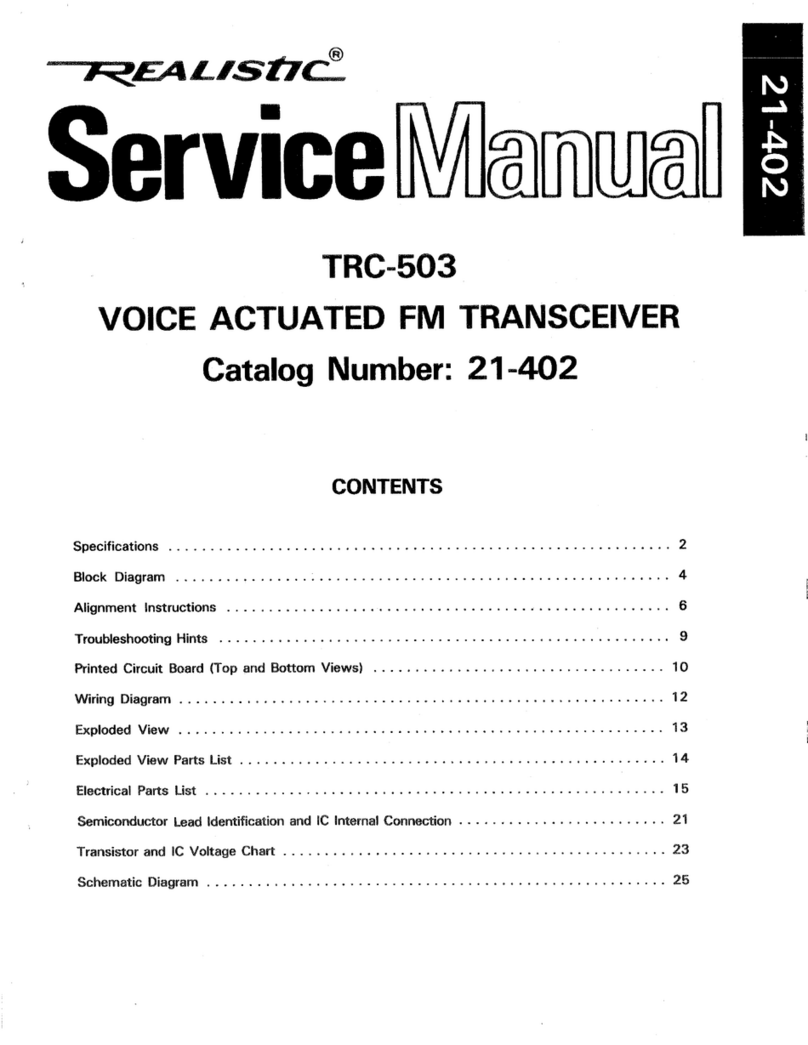
Realistic
Realistic TRC-503 Service manual
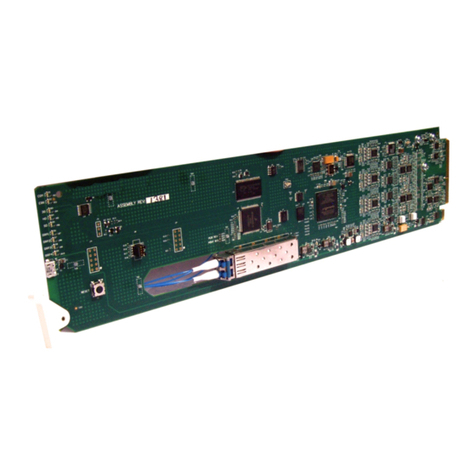
Cobalt Digital Inc
Cobalt Digital Inc 9433-EMDE-75/110 product manual
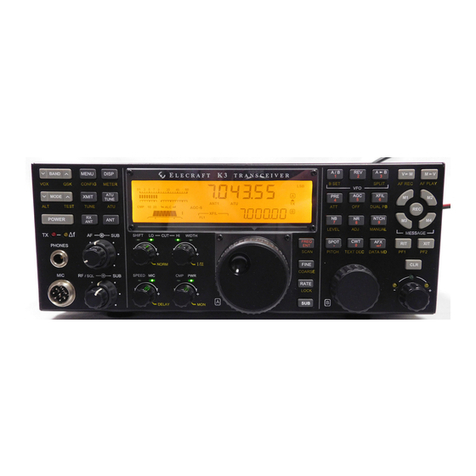
ELECRAFT
ELECRAFT KPA3 installation instructions
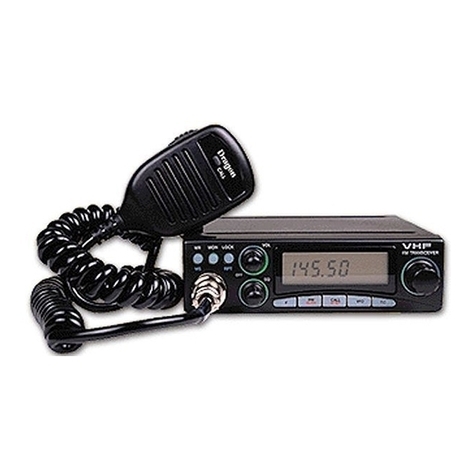
Albrecht
Albrecht AE 550 instruction manual

Vertex Standard
Vertex Standard VX-410 Series operating manual
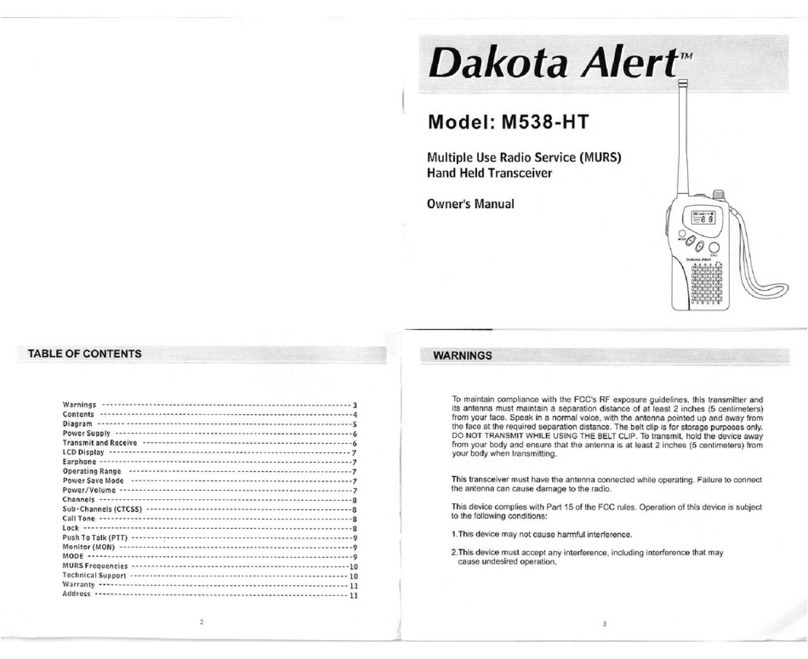
Dakota Alert
Dakota Alert M538-HT owner's manual
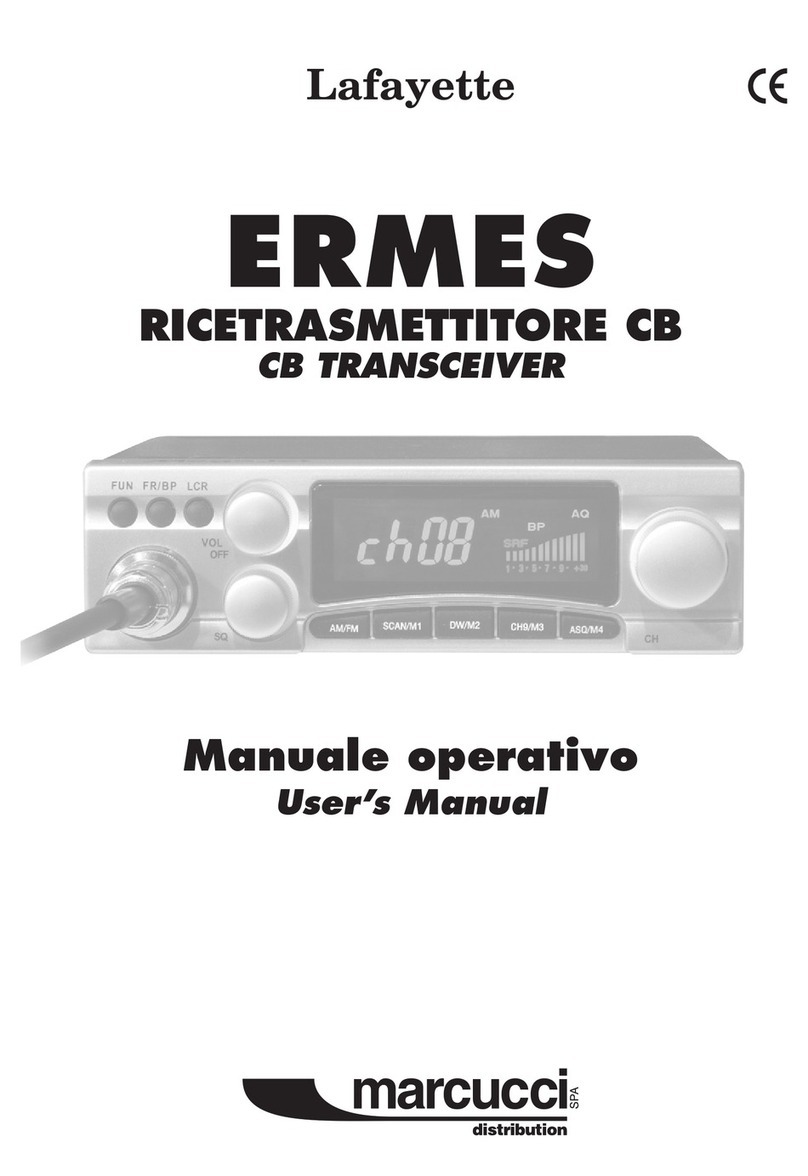
Lafayette
Lafayette ERMES user manual

Kenwood
Kenwood TK 3230 - FreeTalk XLS UHF instruction manual
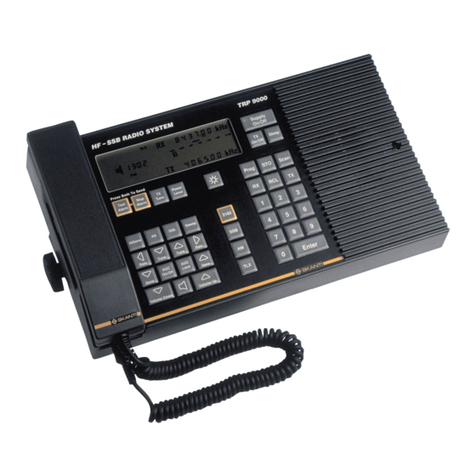
Skanti
Skanti TRP 9500 Technical manual
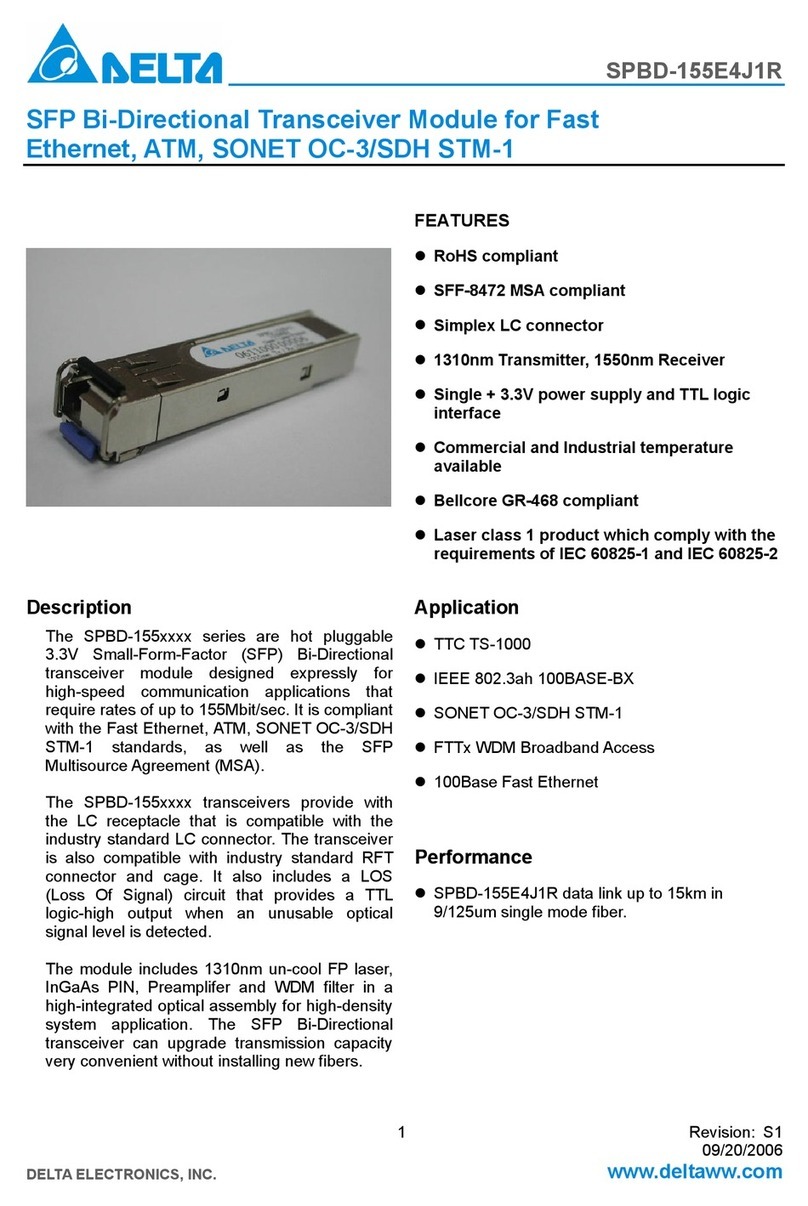
Delta Electronics
Delta Electronics SFP Bi-Directional Transceiver Module... Specification sheet
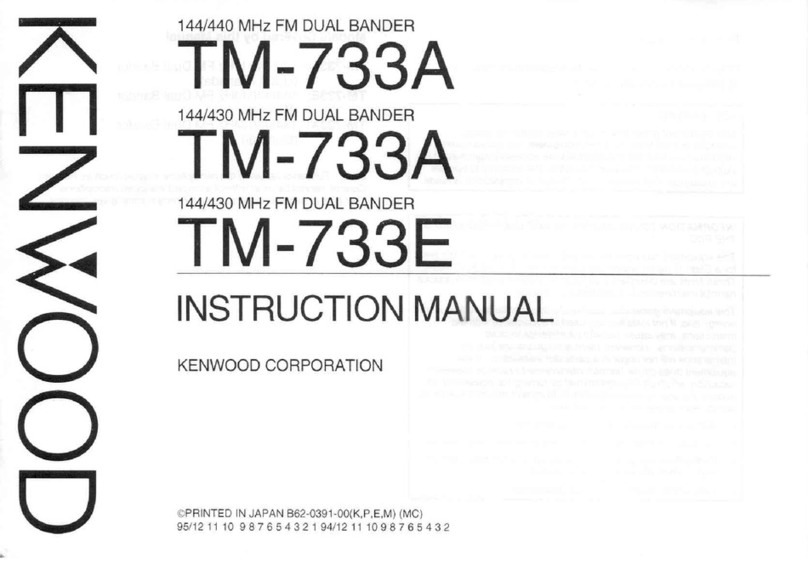
Kenwood
Kenwood TM-733A instruction manual

